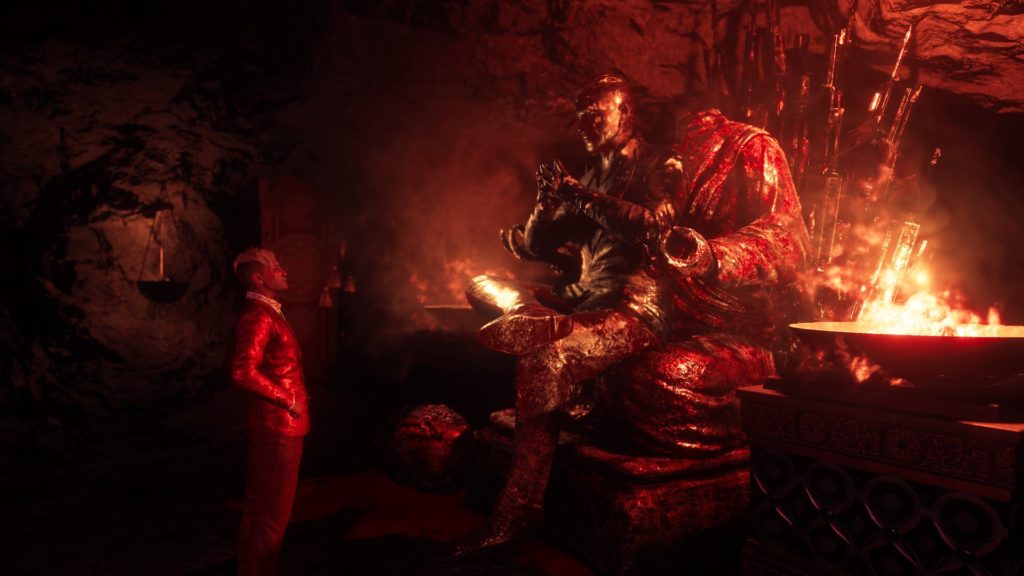The second roguelite DLC for Far Cry 6 puts you in the twisted mind of Pagan Min, bringing back happy memories of Far Cry 4.
One striking feature of Far Cry 6 has been Ubisoft’s commitment to keeping it alive post-launch. It’s the first Far Cry game to have an endgame of sorts, in the form of the ongoing Insurgency system that sees Castillo loyalists reclaiming map areas even after you’ve finished the story and Castillo has died, and a packed map surely contains enough to keep players occupied long after finishing the storyline. We’ve certainly continued to play it.
On top of that, Ubisoft has committed to an imaginative programme of downloadable content, of which Pagan: Control is the third instalment, following Vaas: Insanity and the entirety of Blood Dragon (itself originally a standalone slab of DLC for Far Cry 3). As the name suggests, Pagan: Control is structured similarly to Vaas: Insanity. Which means that it’s a roguelite game using the Far Cry 6 engine, which you play as Far Cry 4’s villain Pagan Min, and which takes place on a map that exists within the confines of Pagan Min’s self-regarding and somewhat tortured mind.
For those who played Far Cry 4, Pagan: Control should provide a powerful nostalgia trip. Just as Vaas: Insanity did, it contains some reimagined scenarios and locations from the original game, given a modern spin by Pagan: Control’s roguelite nature, and if you negotiate them successfully, they will yield actual scenes from Far Cry 4, re-rendered as slightly ghostly memories. All seen from Pagan Min’s perspective, thereby rendering a character who originally seemed inexplicably monstrous at least understandable – especially given the internal monologue which occasionally kicks in as you traverse Pagan: Control’s map.

That map – along with cute touches you encounter while traversing it, such as enemies who die in a puff of multicoloured powder — also offers a nostalgia trip. In keeping with the original game, it’s predominantly mountainous, and bedecked with shrines and gleaming golden temples. Many would argue that Far Cry 4’s best feature was its physical rendition of the kingdom of Kyrat (a sort of amalgamation of Nepal and Tibet) and Pagan: Control offers a condensed version of what is unmistakably Kyrat.
Structural tweaks
In terms of structure, Pagan: Control unsurprisingly adheres to the blueprint established by Vaas: Insanity. The same roguelite-activities can be found, so you must survive trials involving killing specified numbers of enemies to unlock new weapons, negotiate puzzle-and-combat sequences to trigger Pagan Min’s memories, survive trials that throw waves of increasingly tricky enemies at you and open up safehouses by defeating a single wave of enemies.
The latter are crucial, as they allow you to spent the currency (called Respect) you earn by killing enemies and opening chests on upgrading Pagan Min’s attributes and weaponry. In typical roguelite fashion, the early phases of Pagan: Control involve getting to know the map, finding and executing the challenges which bring new weapons, and getting through as many of the map’s activities as possible without dying, in order to, in particular, upgrade your health stats, be able to carry more health syringes and acquire the grapple, parachute and wingsuit, which are particularly handy on a mountainous map.
Beefed-up weaponry
Although the general gameplay is more or less identical to that of Vaas: Insanity, there’s evidence of a little tweaking since that first slab of DLC was released. The safehouses, for example, offer less of a challenge when you seek to gain access to them, and the weaponry – already impressively meaty in Vaas: Insanity – feels even more powerful, especially when you start to upgrade it.
You start off with a pistol, which evolves into something of a beast after a couple of (cheap) upgrades, especially if the random mods you’re given include a silencer and a zoomed sight. The shotgun, meanwhile, pretty much offers one-shot kills for basic enemies (at least if you nail your headshots) from the start, and can be upgraded so that it has a 20-shot magazine, at which point it takes an age to reload (so it pays to augment it with at least one more weapon).

Pagan: Control at times throws lots of enemies at you, but feels as though it also provides you with more firepower with which to dispatch them than Vaas: Insanity did. So, once you feel you have the weaponry you need along with a decent level of health, it’s time to take on the three main missions that yield pieces of Pagan Min’s mask, which are required to trigger the final showdown and escape the baddie’s mind.

The joy of roguelites is that everyone will play them slightly differently, but we found that we were able to beat Pagan: Control much more quickly, having played Vaas: Insanity and learned the conventions and constraints of the particular gameplay that both share. You can also play it in co-op mode with a friend, thanks to a Buddy Pass system which means they don’t need to pay for Pagan: Control.
As with Vaas: Insanity, Pagan: Control has five difficulty levels offering increasingly tough AI. Luckily, it’s sufficiently good fun to encourage you to take them all on. Because of its similarity to Vaas: Insanity, it doesn’t have the air of unexpected innovation that came with finding a roguelite structure built on Far Cry 6’s impressive engine. But it’s still great fun, especially for those with fond memories of Far Cry 4 and, if anything, its structural familiarity lets you enter it with a plan that makes it even more addictive. If judged by the general standards of DLC, it’s clever, absorbing and beautifully made.
